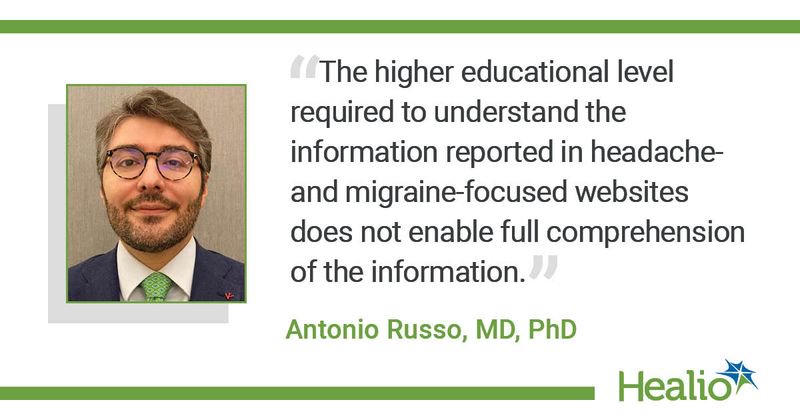Popular headache websites fail to comply with NIH readability guidelines
The first 10 websites found during a search of the words “headache” and “migraine” in the international version of Google featured content that required a reading level above what the NIH recommends, according to findings published in Headache.
“The higher educational level required to understand the information reported in headache- and migraine-focused websites does not enable full comprehension of the information,” Antonio Russo, MD, PhD, associate professor of neurology and director of the Headache Center at the University of Campania in Italy, told Healio Primary Care. “This limits the role of patients in decision-making and can cause patients to adhere to incorrect or potentially harmful attitudes.”

Russo added that though migraine is the most common neurological disorder and primary cause of disability in individuals aged 50 years and younger, “it continues to be underestimated, underdiagnosed and undertreated.”
Researchers entered “headache” and, in a separate search, “migraine” in the international version of Google on April 15, 2018. They used the Simple Measure of Gobbledygook Readability Calculator to analyze the readability of the text on the home pages of the first 10 websites they found.
The researchers reported that the headache websites required an average grade level of 12.4 (± 1.5 standard deviation) and an average 13.3 years of formal education (± 1.7 standard deviation) to comprehend. Searching “migraine” returned websites that needed an average grade level of 10.8 (± 1.2 standard deviation) and an average of 12.5 years of formal education (± 1.9 standard deviation) to comprehend. According to the researchers, NIH guidelines recommend writing health information between sixth and seventh grade readability levels.
Russo said the findings reinforce the notion that primary care physicians and headache specialists should be patients’ principal source of understandable headache-related information.
“PCPs should emphasize the concept of primary headache and the need to consult a headache specialist who can [discuss] appropriate therapies with their patients,” he said.
“Moreover, it is very important to focus on the impact that different types of headaches, particularly migraine, cause. The communication should be easily comprehensible and ‘tailored’ to the degree of literacy of each patient.”
Russo added that he and his colleagues are creating training courses for PCPs that can “provide appropriate tools for a correct diagnostic and therapeutic approach to headache patients.”

